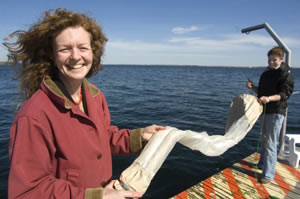
Biology professor Shelley Arnott (left) checks nets used to collect spiny water fleas, an invasive species in Ontario lakes. Photo by Stephen Wild
Reducing the spread of some invasive species into our lakes could be as simple as asking boaters and fishers to dry out their equipment, says Queen's Biology professor Shelley Arnott.
When anchor rope, fishing line and the boats themselves are thoroughly dried, the invasive species and their eggs will die, rather than spreading to another location, she explains. "It's such a simple thing for the general public to do, and yet it could make a big difference in the way that our lake ecosystems function."
Dr. Arnott's current research focuses on the spiny water flea, a small invertebrate predator that has invaded more than 100 North American lakes since the early 1980s, after being transported from Eurasia in the ballast water of ships. With graduate student Angela Strecker, she compared the levels of zooplankton – microscopic, free-floating animals that live on algae and are in turn eaten by small fish – in Ontario lakes invaded by water fleas.
They discovered that production of zooplankton in the warm, upper layer of water in invaded lakes was reduced by almost 70 per cent, compared to lakes that are not invaded. "This reduction in productivity was likely caused by the direct consumption of zooplankton by the fleas," says Dr. Arnott, an expert in aquatic ecology. Another explanation for this dramatic reduction is that zooplankton may have migrated to colder, darker waters, where they would be less visible to predators, she adds.
As a result there is less available food for the small fish that forage in surface waters, such as lake herring, which are in turn are eaten by larger fish, such as lake trout. Biology Master's student, Leah James, is now studying herring growth in lakes invaded by the spiny water fleas.
"What's really concerning is that the introduction of water fleas is having a huge impact on the flow of energy in these lake ecosystems," says Dr. Arnott. "It shows how an invasive species can disrupt the food webs of freshwater lakes by diverting energy and nutrients away from native organisms."
An additional worry is the effect of invasive species like water fleas on lakes that are only now recovering from acid rain, she continues. "When spiny fleas come in, it seems to hit the recovering lakes harder. They're just getting their zooplankton back and the fleas tend to hammer them!"
The combination of environmental stressors – acidification due to sulphur emissions, invasive species and climate change – can have a profound, negative impact on lake ecosystems. But the good news is that some of these effects, particularly from acidification, have been shown to be reversible.
And in the case of invasive species, the researcher notes, one simple method of prevention is to avoid transport
